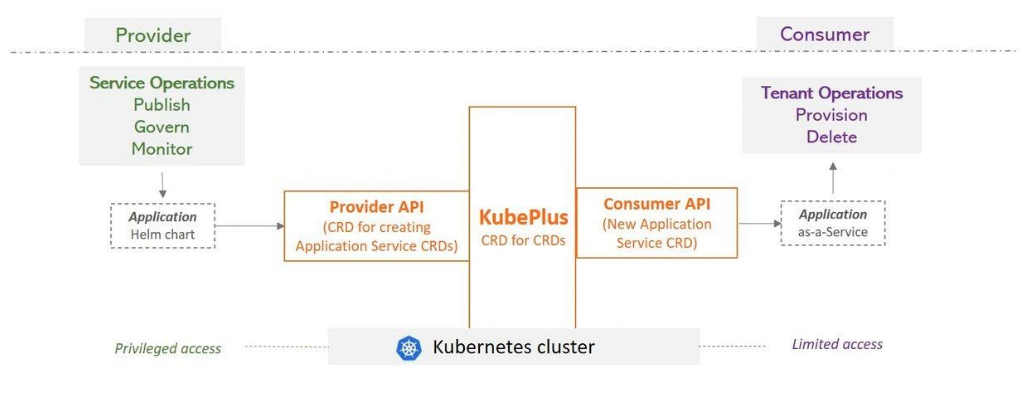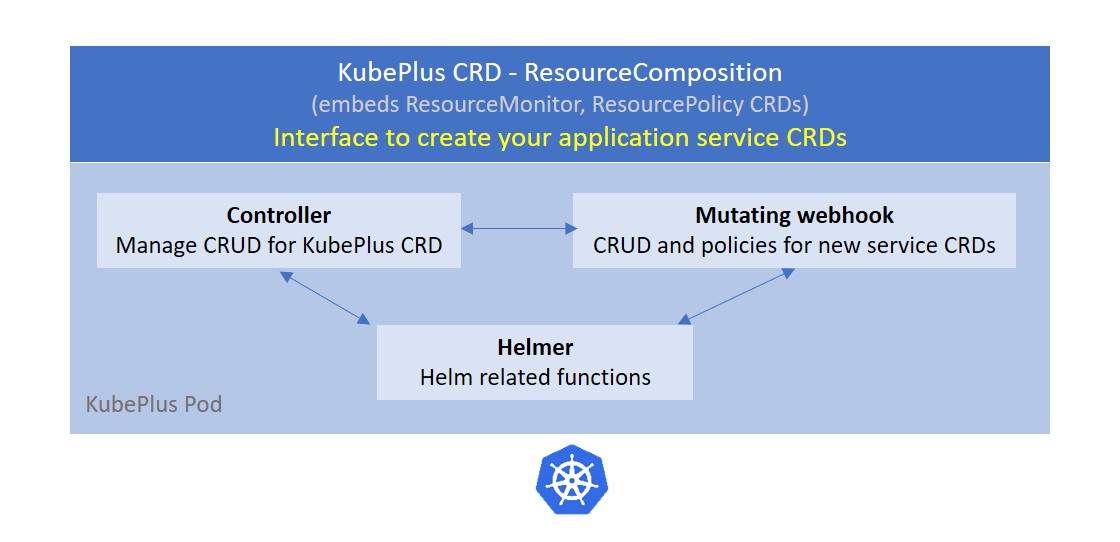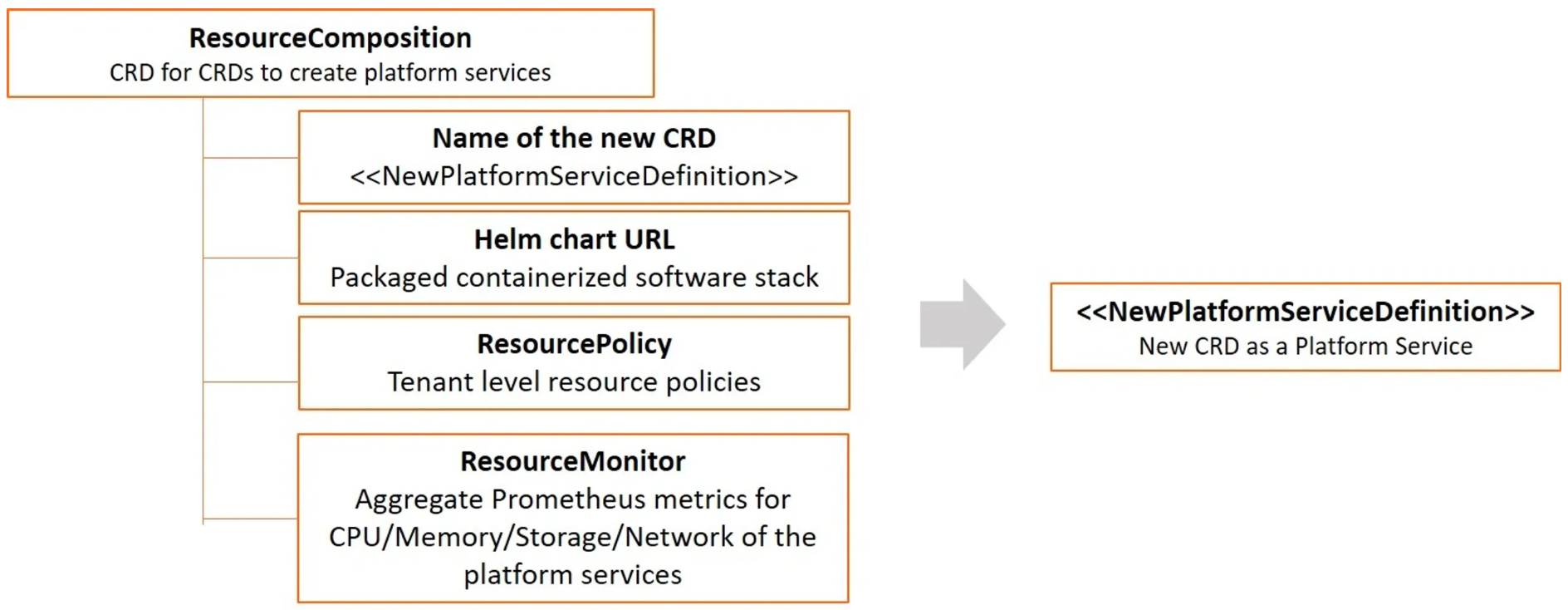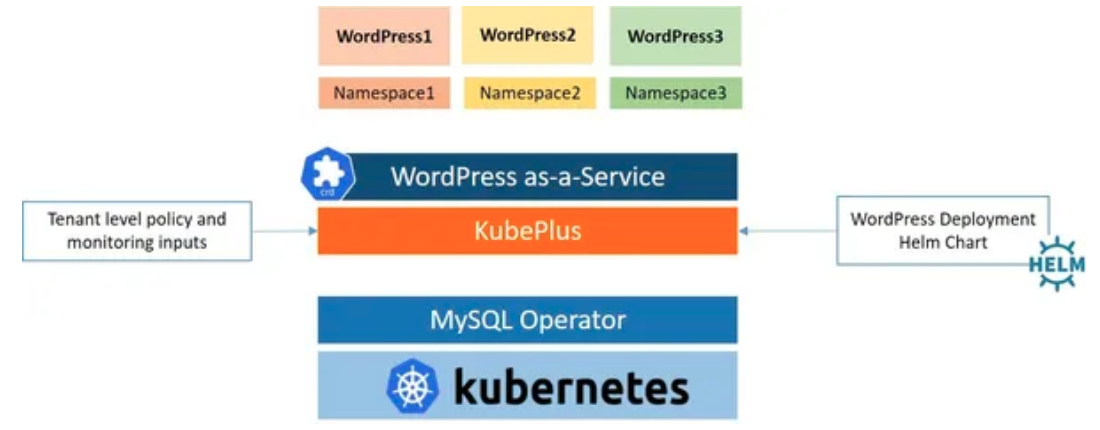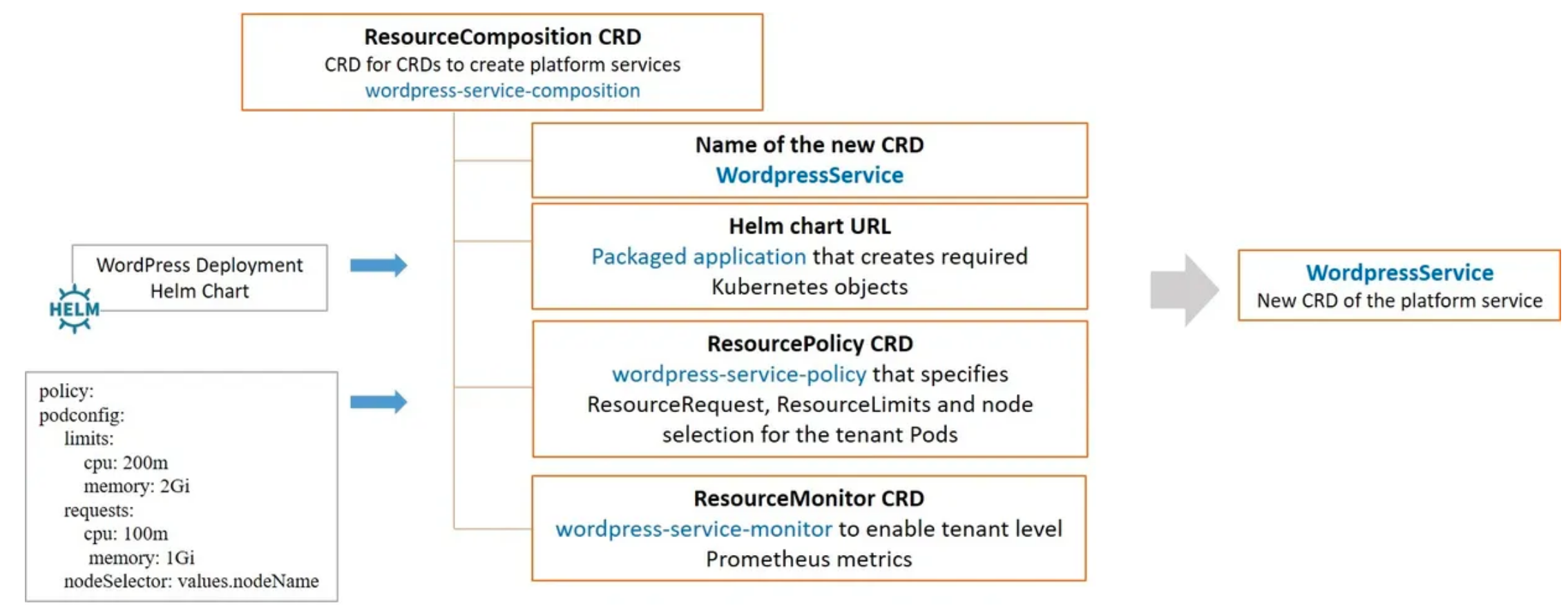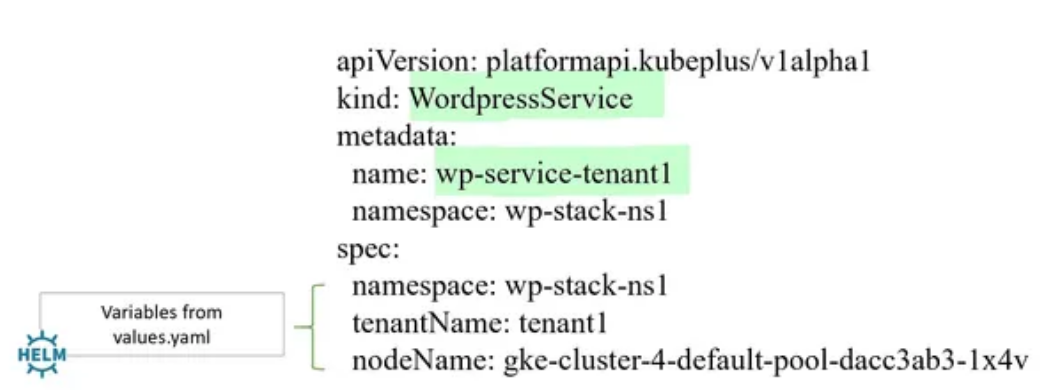Today Platform Engineering teams are dealing with a wide variety of Helm charts coming from different sources - open-source repositories, software vendors, Cloud marketplaces, or enterprise internal stakeholders. The desire is to deliver these custom application stacks as-a-service. Platform teams want an easy way for their customers to instantiate these application instances while being able to manage and monitor them behind the scene.
KubePlus offers a turn-key solution to deliver any Helm chart as-a-service. KubePlus takes an application Helm chart and delivers it as-a-service by abstracting it under provider and consumer APIs. The consumer of the service can simply use Kubernetes native consumer API to provision the application. And behind the scene provider of the service can apply policies and monitor the instances of the application. This open-source KubePlus software forms the foundation for our KubePlus SaaS Manager offering.
KubePlus consists of a CRD that enables creating new Kubernetes APIs (CRDs) to realize such services. The new CRDs enable creation of a Helm release per tenant with tenant level isolation, monitoring and consumption tracking.
KubePlus is designed to help software vendors accelerate their journey to SaaS or enterprise platform teams rapidly deliver managed services for any custom applications.
KubePlus is part of the CNCF landscape's Application Definition section
KubePlus takes an application Helm chart and delivers it as-a-service by automating multi-tenancy management and day2 operations. KubePlus consists of a CRD that enables creating new Kubernetes APIs (CRDs) to realize such services. Provider of the service has privileged access to the cluster and is able to create these services from Helm charts. Consumer of the service has limited access to the cluster and is able to use newly created service API / CRD and create an instance of the application. Behind the scene the provider is able to upgrade, monitor or govern this service.
- Create: Create service for any application packaged as Helm chart.
- Govern: Tenant level policies for isolation and resource utilization.
- Monitor: Tenant level consumption metrics for CPU, memory, storage, network.
- Troubleshoot: Tenant level Kubernetes resource relationship graphs.
KubePlus consists of two components briefly described below.
KubePlus offers a Kubernetes Custom Resource Definition (CRD) named ResourceComposition to
- Compose consumer services wrapping Helm charts
- Define policies (e.g. Node selection, CPU/Memory limits, etc.) for managing resources of the service
- Get aggregated CPU/Memory/Storage/Network metrics for the services (in prometheus format)
Here is the high-level structure of ResourceComposition CRD:
To understand this further let us see how a multi-tenant platform service can be created from WordPress Deployment Helm chart. The Helm chart creates Wordpress pod that depends on a MySQL custom resource. The MySQL Operator is assumed to be installed on the cluster. KubePlus takes Helm chart and other policy and monitoring inputs through ResourceComposition CRD as shown below to deliver a new CRD for Wordpress as-a-Service.
Here is a new platform service named WordpressService.
A new CRD named WordpressService has been created here using ResourceComposition. Wordpress SaaS provider uses a Helm chart that defines the required underlying resources, and additionally, defines the required policy and monitoring inputs, through ResourceComposition. The consumer of the service creates instances of WordpressService. The spec properties of the WordpressService Custom Resource are essentially the attributes exposed via the underlying Helm chart's values.yaml. Here is a YAML definition to create a tenant service instance using newly created WordpressService CRD.
KubePlus kubectl plugins enable users to discover, monitor and troubleshoot service instances. The primary plugin is: kubectl connections. It provides information about relationships of a Kubernetes resource instance (custom or built-in) with other resources (custom or built-in) via owner references, labels, annotations, and spec properties. KubePlus constructs Kubernetes Resource relationship graphs at runtime providing it the ability to build resource topologies and offer fine grained visibility and control over the application service.
Here is the resource relationship graph for WordpressService instance discovered using the kubectl connections command.
kubectl connections WordpressService wp-service-tenant1.
We have additional plugins such as kubectl metrics and kubectl applogs that use resource relationship graphs behind the scene and aggregate metrics and logs for the service instance.
You can also directly get CPU/Memory/Storage/Network metrics in Prometheus format if you setup ResourceMonitor while creating your new CRD.
Details about these components are available here.
- Install KubePlus kubectl plugins. They can be used with any Kubernetes resource (built-in resources like Pod, Deployment, or custom resources like MysqlCluster).
$ wget https://github.com/cloud-ark/kubeplus/raw/master/kubeplus-kubectl-plugins.tar.gz
$ gunzip kubeplus-kubectl-plugins.tar.gz
$ tar -xvf kubeplus-kubectl-plugins.tar
$ export KUBEPLUS_HOME=`pwd`
$ export PATH=$KUBEPLUS_HOME/plugins/:$PATH
$ kubectl kubeplus commands
- Install Helm v3 and install KubePlus in-cluser component using following command. KubePlus can be installed in any Namespace.
$ KUBEPLUS_NS=default (or any namespace in which you want to install KubePlus)
$ helm install kubeplus "https://github.com/cloud-ark/operatorcharts/blob/master/kubeplus-chart-0.2.0.tgz?raw=true" -n $KUBEPLUS_NS
-
Try following examples:
- Hello World service
- Wordpress service
- Mysql service
- MongoDB service
- Multiple teams with applications deployed later
-
Debug:
- kubectl logs kubeplus $KUBEPLUS_NS -c crd-hook - kubectl logs kubeplus $KUBEPLUS_NS -c helmer - kubectl logs kubeplus $KUBEPLUS_NS -c platform-operator - kubectl logs kubeplus $KUBEPLUS_NS -c webhook-cert-setup
As enterprise teams build their custom platforms using community or in house developed Operators, they need a set of guidelines for Operator readiness in multi-Operator and multi-tenant environments. We have developed the Operator Maturity Model for this purpose. Operator developers are using this model today to ensure that their Operator is a good citizen of the multi-Operator world and ready to serve multi-tenant workloads. It is also being used by Kubernetes cluster administrators for curating community Operators towards building their custom platforms.
-
Being a good citizen of the Multi-Operator world, Kubecon NA 2020
-
KubePlus presentation at community meetings (CNCF sig-app-delivery, Kubernetes sig-apps, Helm)
Submit issues on this repository or reach out to our team on Slack.
Actively under development

